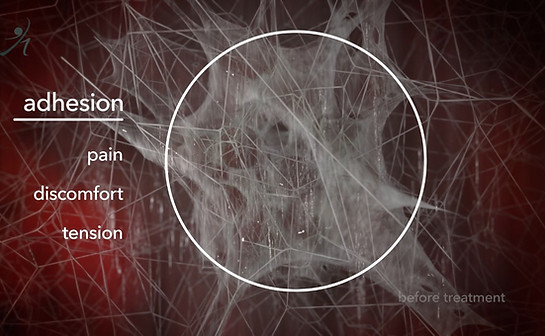
Myofascial Release
Myofascial Release is a very gentle yet effective technique. It works with the fascia - a connective tissue that surrounds every organ, tissue, muscle, bone, ligament and tendon. It is a continuous network and can be compared to a cobweb (see image 1). It acts as our body's shock absorber and communication system.
A healthy fascia is wet, slippery and elastic, allowing for movement. It cushions and supports us so we can move freely.
Fascia is affected by poor posture, injuries, surgery, repetitive movement and trauma (both physical and emotional), all of which cause the fascia to shorten, thicken, and stick together (see image 2). This in turn causes pain and discomfort.
Myofascial release works really well for:
-
Post-surgical rehabilitation
-
Chronic pain conditions like fibromyalgia
-
Repetitive strain injuries
-
Sports injuries
-
Frozen shoulder

1. Healthy fascia

2. Restricted fascia
Myofascial release does just as the name says - it releases the restrictions and allows the fascia to return to its normal functioning.
The effect of the release can be very profound, especially if the restrictions have been present for many years.
Clients can feel the release by tuning into the sensations in their bodies:
heat, cold, pulsations, pins and needles, tightening, waves. Occasionally pain is recreated, or a sense of space is felt. My clients sometimes describe what they feel as a sense of blossoming. All sensations are valid, and are part of the release.
SCAR TISSUE
After surgery your body forms a scar on the skin (see image 3) at the site of surgery, and internally adhesions may form.
Adhesions are bands of scar tissue that form between internal body surfaces, causing organs or tissues to stick together. This can be a painful and debilitating condition, and unfortunately, surgery to remove the adhesions may not always be a permanent solution, as the body will continue to form new adhesions.
Myofascial release can not “break up” scar tissue in the literal sense, but it helps by softening and remodelling the tissue so that it integrates better with the surrounding muscles and fascia.
It works by:
-
relieving fascial tension
-
improving blood flow and circulation
-
stimulating breakdown of adhesions
-
promoting natural healing
This can lead to improved range of motion, reduced pain, and enhanced overall well-being.
If you're experiencing pain or restrictions due to adhesions, I would highly recommend exploring Myofascial Release as a potential treatment option. It's a safe, gentle, and effective way to promote healing of scars.
